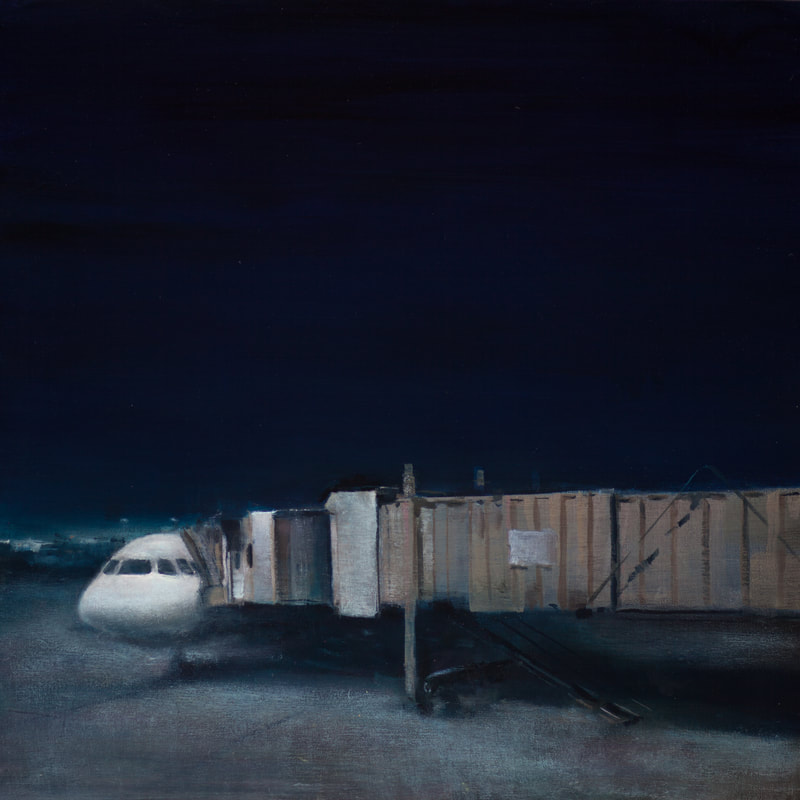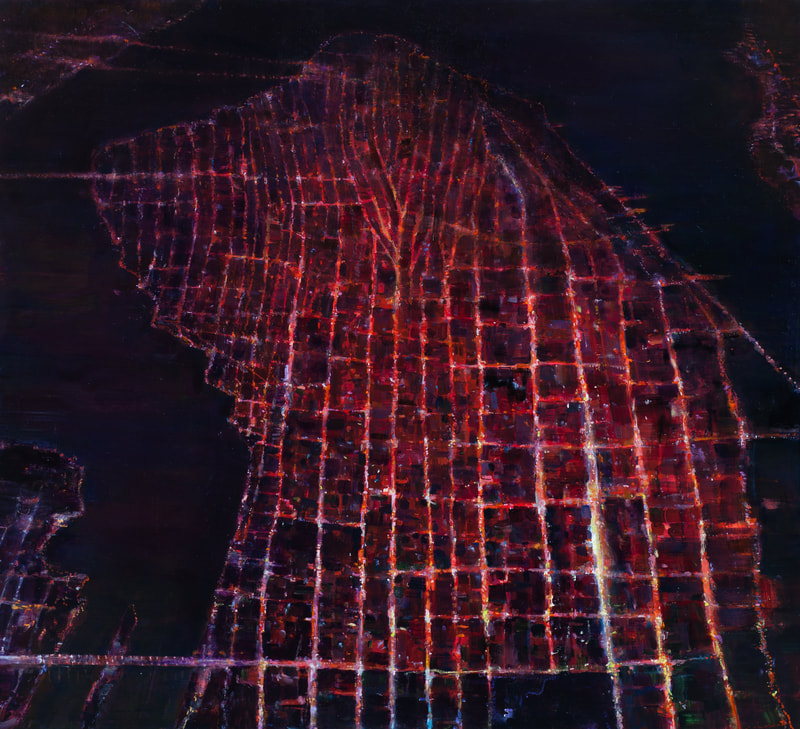ARTIST STATEMENT
Trevor Young is a quintessentially American painter. He makes no bones about his affection for the trappings of car culture, life on the road, and 1960s West Coast art. His main subject is modernism’s footprint on the outposts of Americana—places typified by harsh artificial light and hard shadows on concrete. The show makes clear that for Young, despite the contemporary art world’s preferences for irony, disjunction, and tongue-in-cheek intellectual gamesmanship, painting is at its best when it attempts to offer an unpretentious accounting of where and how we live our day-to-day lives.
The celebrations of urban sprawl offered by artists like Ed Ruscha—who famously took no-nonsense aerial photographs of thirty four LA parking lots in 1967, and created sleek, stripped down paintings of Standard Oil stations—are an obvious point of reference in Young’s work. But Young’s choices seem more personal than Ruscha’s, and his technique is certainly more painterly: His images of gas stations are uneasy amalgamations, cobbled together from his own memories of road trips, photographs, and pure invention, and rendered with a sense of atmosphere and drama seemingly at odds with his use of hard lines and simple geometric shapes.
Painters today tend to lean on pastiche, on art-historical mashups and code-switching. This typically results in images with no unified style and no concern for pictorial space, illusionistic or otherwise. For many contemporary painters, the picture plane is simply a flat, delimited arena in which different types of visual syntax collide, floating freely. This is a non-strategy in which artists make an end run around some of the thornier problems of composition, perception, and cognition.
Young bucks this trend. He activates every square inch of his canvases, blocking in large passages of negative space with skeins of scruffy countervailing strokes. He is not a fussy painter, nor is he out to prove his own mastery to an audience. Like Edward Hopper, Young tends to eschew a lot of paint’s seductive properties, preferring to create hard edges and large, gently undulating planes of subdued color.
He draws the viewer into an unpopulated, uncluttered world with a clear horizon line—but one that is also filled with hiccups, discontinuities, and compromises. In Service in the Rear, for example, a shelter for gas pumps in the foreground—closest to the viewer and, therefore, logically a dominant compositional element—is rendered as a hazy silhouette that flagrantly disobeys the rules of linear perspective. This is intentional: The structure is only important to Young in the way that it draws the viewer’s eye below and past it, to the glowing, low-slung building dominating the lefthand side of the picture. Thus Young shows his talent for creating visual tension and drama—and for sidestepping the viewer’s expectations.
Young understands that some might regard his brand of painting as obsolete. He also understands the troubled legacy of modernism, and what the triumph of universal technology has meant for cultures around the globe. Still, for Young, the cold comfort offered by outposts of convenience—gas stations, airports, cheap hotel rooms—is not so easily dismissed. Young shares the strange buoyant optimism of his hero, Jonathan Richman, who, in his early ‘70s proto-punk single, Roadrunner, exults in the simple act of driving past the Stop’n’Shop with the radio on. Richman sings about the bleakness of life at highway speeds and the solitude enforced by vacant mass culture and convenience stores—but in that bleakness, Richman recognizes himself, and the experience becomes thrilling. Spending time with Young’s paintings, one can’t help but feel the echoes of that thrill.
The celebrations of urban sprawl offered by artists like Ed Ruscha—who famously took no-nonsense aerial photographs of thirty four LA parking lots in 1967, and created sleek, stripped down paintings of Standard Oil stations—are an obvious point of reference in Young’s work. But Young’s choices seem more personal than Ruscha’s, and his technique is certainly more painterly: His images of gas stations are uneasy amalgamations, cobbled together from his own memories of road trips, photographs, and pure invention, and rendered with a sense of atmosphere and drama seemingly at odds with his use of hard lines and simple geometric shapes.
Painters today tend to lean on pastiche, on art-historical mashups and code-switching. This typically results in images with no unified style and no concern for pictorial space, illusionistic or otherwise. For many contemporary painters, the picture plane is simply a flat, delimited arena in which different types of visual syntax collide, floating freely. This is a non-strategy in which artists make an end run around some of the thornier problems of composition, perception, and cognition.
Young bucks this trend. He activates every square inch of his canvases, blocking in large passages of negative space with skeins of scruffy countervailing strokes. He is not a fussy painter, nor is he out to prove his own mastery to an audience. Like Edward Hopper, Young tends to eschew a lot of paint’s seductive properties, preferring to create hard edges and large, gently undulating planes of subdued color.
He draws the viewer into an unpopulated, uncluttered world with a clear horizon line—but one that is also filled with hiccups, discontinuities, and compromises. In Service in the Rear, for example, a shelter for gas pumps in the foreground—closest to the viewer and, therefore, logically a dominant compositional element—is rendered as a hazy silhouette that flagrantly disobeys the rules of linear perspective. This is intentional: The structure is only important to Young in the way that it draws the viewer’s eye below and past it, to the glowing, low-slung building dominating the lefthand side of the picture. Thus Young shows his talent for creating visual tension and drama—and for sidestepping the viewer’s expectations.
Young understands that some might regard his brand of painting as obsolete. He also understands the troubled legacy of modernism, and what the triumph of universal technology has meant for cultures around the globe. Still, for Young, the cold comfort offered by outposts of convenience—gas stations, airports, cheap hotel rooms—is not so easily dismissed. Young shares the strange buoyant optimism of his hero, Jonathan Richman, who, in his early ‘70s proto-punk single, Roadrunner, exults in the simple act of driving past the Stop’n’Shop with the radio on. Richman sings about the bleakness of life at highway speeds and the solitude enforced by vacant mass culture and convenience stores—but in that bleakness, Richman recognizes himself, and the experience becomes thrilling. Spending time with Young’s paintings, one can’t help but feel the echoes of that thrill.
|
RESUME
|
PRESS RELEASE
|
















